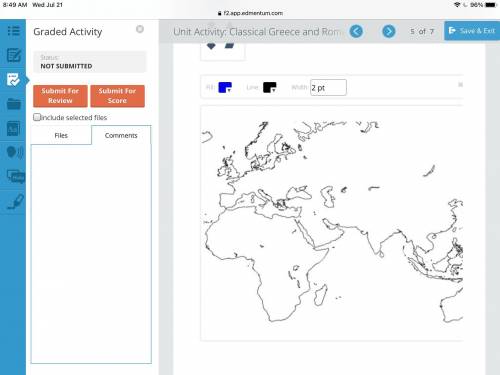
History, 21.07.2021 16:00 wendii87wh
Part B In this part of the activity, you will plot elements in the drawing field to create your map of the trade routes used during the time of the Roman Empire. Alternatively, print out this baseline map, draw the elements by hand, and turn in the completed map to your teacher. Begin by drawing these elements on the base map: a key or legend that tells your audience what each symbol, shape, or color on your map represents (for example, your key may show that a red region indicates the Indian civilization) a compass rose, a figure that shows the main directions on your map (north, south, east, and west) important geographical features, such as mountains and rivers, along with their names (for example, you may indicate the Indus River with a blue line) colors to indicate the three main trading regions—the Roman Empire; the Asian civilizations of India, China, and Persia; and the African civilizations of Axum and Kush Next, research the trade routes that were in use between the Roman Empire and the civilizations of Africa and Asia. Then draw the major trade routes on the map. Make sure that you plot trade routes that include these regions and cities: Roman Empire Egypt Persia Arabia India Meroë (city in the Kush kingdom) Adulis (city in the Axum kingdom) Mediterranean Sea and the Indian Ocean !DRAW IT OUT ON THE MAP!


Answers: 3


Other questions on the subject: History


History, 21.06.2019 22:00, Isaiahtate053
During world war ll, which was an axis nation ? china hong kong japan the philippines
Answers: 2

History, 22.06.2019 04:00, kimmosley80
Enter the word you receive when you completed the river valley civilizations activity
Answers: 2

History, 22.06.2019 05:30, loganparrish2488
Imagine you are a historian studying a battlefield journal written by a soldier serving in world war i. describe the process of interpreting the information within the journal, as well as how you would determine whether the evidence in the journal is valid
Answers: 2
You know the right answer?
Part B In this part of the activity, you will plot elements in the drawing field to create your map...
Questions in other subjects:

Mathematics, 10.02.2020 09:47

English, 10.02.2020 09:48

Business, 10.02.2020 09:49



History, 10.02.2020 09:49


Computers and Technology, 10.02.2020 09:49

Social Studies, 10.02.2020 09:49

Biology, 10.02.2020 09:49



